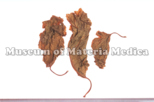Mulberry Leaf

|
TMPW No.:3156 |
| Synonym | |
| Latin name | Mori Folium |
| Botanical source: Family name | Moraceae |
| Botanical source: Plant name | - Morus alba Linné (IPNI:30051955-2) - Morus bombycis Koidzumi (IPNI:584340-1) |
| Part used | Leaf |
| Empirical criteria for quality selection | Unknown |
| Constituents | Carotenoids & Vitamin A: Vitamin A-like substances, Carotene Sterols: Ergosterol Flavones & Flavonols: Flavone constituent Sulfur containing alkaloids: Vitamin B1 |
| Pharmacological effects | Antibacterial, bacterial inhibition (Bacillus typhosus, Staphylococci) |
| Indications | As an antifebrile, antitussive, for cooling the blood and improving eyesight, it is applied to treat cold, cough, headache, eye disease, beriberi, edema, abdominal pain, diarrhea and blood stasis. |
| Diseases | Common cold, Cough, Headache, Asthenopia, Beriberi, Edema, Abdominal pain, Diarrhea, Contusion |
| Formulas | |
| Meridian tropism | Heart, Liver, Kidney |
| Property | Cold |
| Flavor | Sweet |
| Classification in "Shen-non Ben-cao Jing" | |
| TCM: Classification | Diaphoretics |
| TCM: Medicinal effects | To dispel wind-heat and to remove heat from the lung, to subdue hyperactivity of the liver and improve eyesight.: For upper respiratory infection, heat in the lung with dry cough, dizziness, headache, inflammation of the eye, and blurred vision. |
| Remarks | |
| References |
